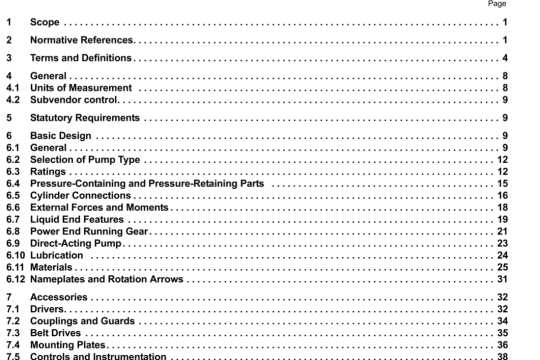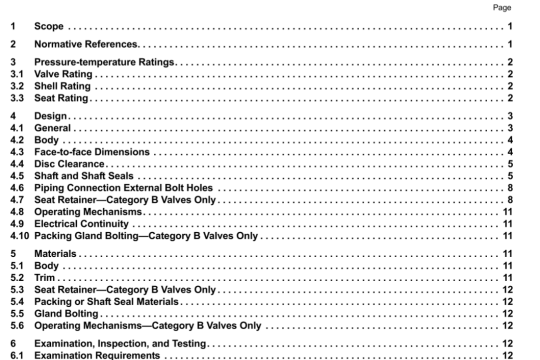API STD 1529:2005 pdf download
API STD 1529:2005 pdf download.AVIATION FUELLING HOSE AND HOSE ASSEMBLIES.
4.4.5 Adhesion
The adhesion between the hose components shall be a minimum of 3 Newton/mm (17.1 pounds force/inch) of width for dry components and 2 Newton/mm (11.4 pounds forccinch) of width after contact with fuel.
4.4.6 Vacuum resistance
Type C and Type CT hose assemblies having internal
diameters of 63 mm (2.5 inches) or less shall withstand
a suction of 5 inches of mercury (2.5 psi) and retain
80 % of the original internal diameter when tested at
200C±50C(680F±9DF).
Hose Type C and Type CT shall withstand a suction of 25,5 inches of mercury (12,5 pounds per square inch) for 10 minutes at 20 °C ± S °C (68 °F ± 9 °F) without suffering visual collapse of the tube. reinforcement, or outer cover, Hose Types E and F shall withstand a suction of 20 inches of mercury (10 pounds per square inch) for 10 minutes at 20 °C ± 5 °C (68 °F
* 9 °F) and retain 80% of the onginal internal diameter without suffering visual collapse of the tube. reinforcement, or outer cover.
4.4.7 Flexibility
The flexibility of the hose at 20 °C ± 5 °C (68 °F ±9 °F) shall be such that, when empty, it may be coiled around a test drum having an external diameter as specified in section 6.5.6 without suffering structural damage or kinking. After the hose is uncoiled, it shall show no signs of fatigue or permanent deformation (including length change) and, for Types C. CT and F hoses, no increase in electrical resistance outside the limits specified in 4.4.8.
The hose shall be flexible and retain pressure capabilities at temperatures ranging down to -30 °C ± 1 °C (-22 F ± 2 °F) for normal hose and -40 °C
± 1 C (-40 F ± 2 F) for CT hose. The manufacturer shall submit hose testing results indicating the maximum registered torque required to bend the hose around the test drum at a temperature of -30 °C (-22 °F) for normal hose and -40 °C (-40 °F) for CT hose. The test hose specimen shall be pre-conditioned in a cold chamber at the test temperature for 24 hours prior to testing. The test drum and specimen for hoses with inside diameters of 75 mm (3 inches) and smaller shall be kept in the cold boxbath during the test to ensure the test temperature is maintained. For hoses with inside diameters larger than 75 mm (3 inches). the test drum and specimen must be at the lest temperature but may be removed from the cold box/bath for the test procedure. In this ca.se the test must be initiated within 30 seconds of removal from the cold box.’bath.
6.4.6 Resistance to aging test
The change in tensile strength and elongation at break of tube shall be measured in accordance with ISO 188 (Air Oven Method) or ASTM 1) 573 [seven days at 70 C (158 °F)]. The test result shall be within the tolerance specilied in section 4.3.6,
6.4.7 Cold cmhrittlcrncnt test
The apparatus for the cold embriulement test is shown in Figure I.
The hose tube and cover shall be tested individually forcold cmbnttlerncnt at -40°C ± I °C(-40 °F ± 2 DF) for normal hose: -48 C * I ‘C (-55 ‘F * 2 ‘F for CT hoses) in accordance with either ASTM D 380 or the procedures given below. The test results shall satisfy the requirement of section 4.3.7.
(a) Fix a test sample measuring 150mm x 25mm x 2 mm (± 0,5 mm) in iwo grips (see Figure I) so that it lies in one plane with an exposure of 127 mm between the grips. Reduce the distance between the gripsby 1mm.
Note: If a sample of tube or cover from a hose is to be tested, remove any adhering reinforcement.
(b) Place the clamped test sample in a Dewar vessel containing a coolant so that the sample is completely immersed.
Note: A temperature of -40°C ± I °C (-40°F ± 2 °F) or -48 °C ± I °C (-55 °F ± 2 °F) may be attained by using methanol or ethanol with crushed dry ice (solid carbon dioxide) and maintained by adding further pieces of dry ice.
(c) Maintain the temperature of -40°C * I °C (-40°F *2 °F)or-48°C± I °C(-55°F±2°F)for30 minutes, Then reduce the distance between the grips by 25 mm ± 2 mm in 20 seconds by moving one grip directly toward the other in the same plane.




